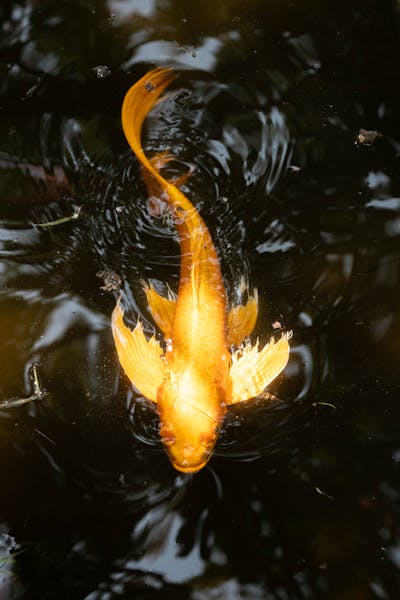
Goldfish are one of the most popular pet fish in the world, known for their vibrant colors, calm behavior, and relatively simple care requirements. However, many new fish owners make the mistake of assuming that feeding a goldfish is as easy as dropping food into the tank once in a while. In reality, how often and how much you feed a goldfish plays a crucial role in its overall health, longevity, and water quality in its tank or bowl.
Feeding is not just about giving your goldfish something to eat. It’s about providing the proper nutrition in the right amounts and at the right frequency to ensure they stay healthy and active. Overfeeding or underfeeding can lead to a number of problems that affect not only the goldfish itself but also the environment it lives in. A well-fed goldfish will have vibrant colors, an active swimming style, and a longer life.
The general recommendation for feeding a goldfish is one to two times per day. This schedule works well for most adult goldfish living in home aquariums. Younger goldfish or fry may require more frequent feeding, usually two to three times a day, because they are growing and need more energy. It’s also essential to feed them at consistent times each day, helping establish a routine and keeping their digestive systems regular.
The amount you feed is just as important as how often. A good rule of thumb is to give your goldfish only what it can eat in under two minutes. Any leftover food that settles at the bottom of the tank can break down and pollute the water, potentially leading to health problems. Some aquarists also recommend feeding based on the size of the fish—roughly the size of the goldfish’s eye in dry food per feeding.
Several factors influence how often you should feed your goldfish. First, the age and size of the fish matter. Younger fish are more active and grow rapidly, requiring more frequent meals. Larger, older fish are generally less active and need fewer calories, so feeding once a day may be sufficient. The size of the tank and the effectiveness of the filtration system also play a part. In smaller tanks or bowls with minimal filtration, feeding less is safer to prevent rapid water contamination.
Water temperature is another important factor. Goldfish are cold-water fish, and their metabolism slows down significantly in colder water. In winter months, or if your tank water is naturally cooler, your goldfish may eat less or even stop eating altogether. In warmer conditions, their metabolism speeds up, and they may need to be fed a bit more—but always cautiously to avoid overfeeding.
Overfeeding is one of the most common mistakes made by goldfish owners. When goldfish eat more than they need, it can lead to several health issues. A common problem is bloating, which can make it hard for the fish to swim properly. Another is swim bladder disorder, where the fish has trouble maintaining its buoyancy and may float to the top or sink to the bottom of the tank. Excess food also decays and releases harmful toxins like ammonia into the water, making it unsafe for the fish to live in.
To avoid these issues, it’s essential to observe your goldfish during and after feeding. Are they eating eagerly? Are they leaving food behind? Are they swimming normally? These are all signs that can help you adjust your feeding routine accordingly. A goldfish that is well-fed but not overfed will be active, have a good appetite, display bright colors, and grow at a steady rate.
Different types of food can also affect feeding frequency and amount. Goldfish can be fed pellets, flakes, gel food, or even fresh vegetables like peas and spinach. Each type has different properties—pellets may sink or float, while flakes dissolve faster and can pollute the water more easily. It’s important to choose high-quality food specifically designed for goldfish, as they have different nutritional needs compared to tropical fish. Feeding them a varied diet helps ensure they get all the nutrients they need.
Many goldfish owners wonder whether they can skip a feeding or two, especially if they are going on a short trip. The answer is yes—healthy adult goldfish can go without food for a couple of days without any problems. In fact, skipping a day now and then can help prevent overfeeding and mimic their natural eating patterns in the wild. However, this should not be a regular practice, especially for young or growing goldfish.
Feeding needs can change over time. As goldfish age, their metabolism slows, and they require less food. Regularly observing your goldfish and adjusting feeding amounts based on their behavior and tank conditions is key to long-term health. If you notice your fish becoming sluggish or if the water becomes cloudy soon after feeding, it may be time to reevaluate how much you’re feeding.
To ensure healthy feeding habits, always remove uneaten food after a few minutes to keep the tank clean. Use a feeding ring or designated area in the tank to make it easier to monitor how much your goldfish is eating. Consider fasting your goldfish one day a week to give their digestive system a rest.
In conclusion, feeding your goldfish properly is essential to their overall health and the cleanliness of their environment. Aim to feed them one to two times daily, using an amount they can finish in under two minutes. Take into account their age, the tank conditions, and the water temperature when planning feeding routines. Avoid overfeeding at all costs, and watch for signs of bloating, inactivity, or leftover food. With the right feeding schedule and good observation habits, your goldfish can live a long, healthy, and happy life.